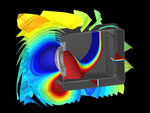 Application of finite element analysis (FEA), boundary element analysis, or computational fluid dynamics simulation techniques to product design is well established in many industry sectors for fundamental static, thermal and dynamic environments.
Application of finite element analysis (FEA), boundary element analysis, or computational fluid dynamics simulation techniques to product design is well established in many industry sectors for fundamental static, thermal and dynamic environments.
There are a number of methods reported with respect to Vibro-Acoustics and Shock excitation, classical methods, FEA, boundary elements and Statistical Energy Methods.
Is there a coherent summary of the methods and benchmarks that illustrate and verify the application of these techniques such that the methods can be as routinely applied as a design tool?
This workshop included:
- Presentations from a variety of industry sectors describing the application of Vibro-Acoustic analysis and modelling techniques to product design.
- Presentations by vendors of typical methods available for modelling and analysis of Vibro-Acoustic and shock environments.
Presentations (for download by attendees only)
 Modelling Vibro-Acoustics: Why, How What and WhereNext? - An overview of the workshop theme and possible issues for discussion
Modelling Vibro-Acoustics: Why, How What and WhereNext? - An overview of the workshop theme and possible issues for discussion
Colin McCulloch, Dynamic Structures and Systems Limited
 Vibro-Acoustic Analysis of Spacecraft Structures, Tools and Methodologies
Vibro-Acoustic Analysis of Spacecraft Structures, Tools and Methodologies
J. Santiago Prowald & I. Ngan, European Space Agency
 Air-Borne and Structure-Borne Noise Analysis in a Luxury Yacht
Air-Borne and Structure-Borne Noise Analysis in a Luxury Yacht
Kevin Hamson, Frazer-Nash Consultancy
 Railway Vibro-Acoustic Analysis
Railway Vibro-Acoustic Analysis
Chris Jones, ISVR Southampton University
 High Frequency Acoustic Analysis via Energy Finite Elements
High Frequency Acoustic Analysis via Energy Finite Elements
Jesus Blanco, Advanced Analysis Ltd
 Waves and Finite Element Analysis
Waves and Finite Element Analysis
Yoshiyuki Waki, ISVR, Southampton University
 Vibro and Aero-Acoustic Simulations
Vibro and Aero-Acoustic Simulations
Jean-Louis Migeot, FFT, Louvain-la-Neuve
Innovative Solutions for Low, Mid and High Frequency Vibro-Acoustic Simulation
Trevor Edwards, ESI
 Innovative Solver Technology to Beat the Boundary Element Computational Bottleneck
Innovative Solver Technology to Beat the Boundary Element Computational Bottleneck
Peter Segaert, LMS CAE Division
 Applications of Coupled Fluid-Structure Acoustics
Applications of Coupled Fluid-Structure Acoustics
Reinhard Helfrich, INTES
Issues addressed included:
- What Vibro-Acosutics and Shock simulation techniques are available?
- How current Vibro-Acoustics and Shock simulation tools have been applied in industry to address product design with respect to these environments.
- Are Vibro-Acoustics and Shock modelling and analysis techniques mature enough to influence product design?
- What is required to improve the effective application of Vibro-Acoustic s and Shock simulation techniques by industry?
Who Attended?
Managers and engineers responsible or involved in the design and analysis of their company’s products.
Academics and researchers involved in teaching, standards and benchmarking of simulation techniques.
The workshop included presentations on Vibro Acoustics and Shock simulation techniques from users and vendors. There was opportunity to discuss the maturity of Vibro Acoustics and Shock modelling and analyses tools and identify the scope of future developments to encourage the effective application of the techniques to product design for Vibro-Acoustics and Shock excitation.

 Application of finite element analysis (FEA), boundary element analysis, or computational fluid dynamics simulation techniques to product design is well established in many industry sectors for fundamental static, thermal and dynamic environments.
Application of finite element analysis (FEA), boundary element analysis, or computational fluid dynamics simulation techniques to product design is well established in many industry sectors for fundamental static, thermal and dynamic environments.
